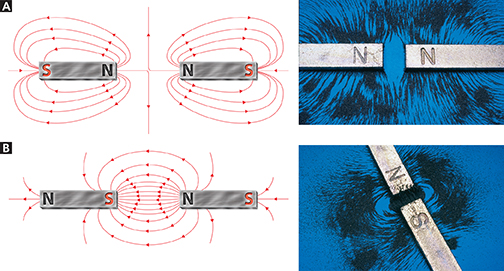Magnetic Fields
A magnetic field surrounds a magnet and can exert magnetic forces. In Figure 2, iron filings are used to show the shape of the magnetic field around a bar magnet.  A magnetic field, which is strongest near a magnet's poles, will either attract or repel another magnet that enters the field. The field lines begin near the magnet's north pole and extend toward its south pole. The arrows on the field lines indicate what direction a compass needle would point at each point in space. Where lines are close together, the field is strong. Where lines are more spread out, the field is weak.
A magnetic field, which is strongest near a magnet's poles, will either attract or repel another magnet that enters the field. The field lines begin near the magnet's north pole and extend toward its south pole. The arrows on the field lines indicate what direction a compass needle would point at each point in space. Where lines are close together, the field is strong. Where lines are more spread out, the field is weak.
Figure 2 A magnetic field surrounds every magnet. Iron filings reveal the field lines, which start near the north pole and extend toward the south pole. Interpreting Diagrams In which two areas of a bar magnet is the field strongest?
 d
dMagnetic Fields Around Magnets
You can use iron filings to visualize how magnetic fields of two magnets interact. Figure 3A shows the north pole of one magnet facing the north pole of another magnet. Notice that there are no iron filings in the gap between the magnets. Iron filings are not attracted to this area because the combined magnetic field is very weak. Figure 3B shows the combined field of two magnets with opposite poles facing each other. The field lines start at the north pole of one magnet and extend to the south pole of the other magnet. The field in the gap between the magnets is very strong, as you can see from the dense crowding of iron filings in this area.
Figure 3 Iron filings reveal the combined magnetic field of two interacting magnets. A When like poles of two magnets come together, the magnets repel each other. B When opposite poles of magnets come together, the magnets attract each other.
 d
d



